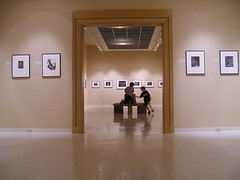On April 18, 1906, an aftershock from the famous San Francisco earthquake flung the four-year-old Ansel Adams against a brick wall, smashing his nose and leaving a leftward twist in it for the rest of his life -- almost as if the earth were marking him for its own.
Adams has become the best known and probably the best-loved of American landscape photographers, though he himself would probably eschew the term "landscape photographer" since in his lifetime, he also did portrait photography, commercial photography, photography dealing with "found objects", and even some documentary photography. Nonetheless, what we envision when we think of Adams are his breathtaking vistas of the American West.
Adams was also a tireless worker for conservation, beginning with a membership in the Sierra Club in the 1920s, and carrying its message to every president from Franklin Delano Roosevelt to Ronald Reagan. He was the first recipient of the Wilderness Society's Ansel Adams Conservation Award, established in 1980. In 1985, the California Wilderness Bill designated over 200,000 acres as the Ansel Adams Wilderness Area and an 11,760 ft. peak in California was named Mt. Ansel Adams. Adams always claimed:
"The artist has an inescapable obligation . . . both the natural and the human world are imperiled . . . this peril lies in overpopulation, pollution, depletion of resources, and the destruction of natural and cultural beauty. The power of art to counteract this destruction, not merely to veil it, is -- I am sure -- tremendous."
Today, the photographic prints that Adams once sold for $10 apiece are worth tens of thousands of dollars and their status as art is assured. In addition to the fine art prints, posters, books, and calendars utilizing his work generate millions of dollars every year. But in the end, what matters is the way his photographs reconnect us to our planet, to its beauty, to its fragility -- in his words, "to reveal to others the grandeur and potential of the one and only world which we inhabit". Perhaps his life's work is best expressed in the words with which he ends his autobiography, quoting an ancient Gaelic mantra taught to him by Ella Young:
"I know that I am one with beauty
And that my comrades are one.
Let our souls be mountains,
Let our spirits be stars,
Let our hearts be worlds."
Please see the RW Norton Art Foundation web site.
Subscribe to:
Post Comments (Atom)





No comments:
Post a Comment